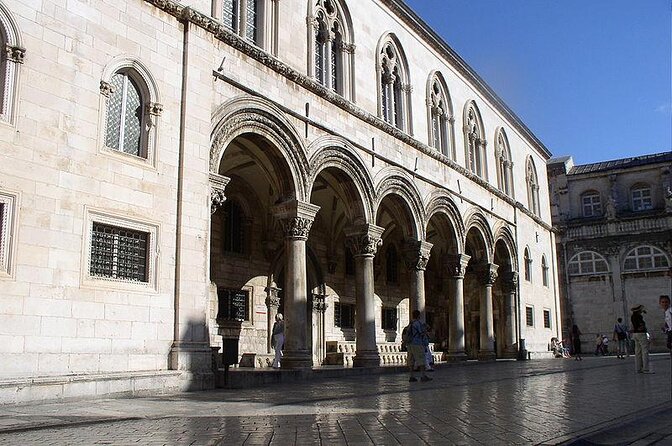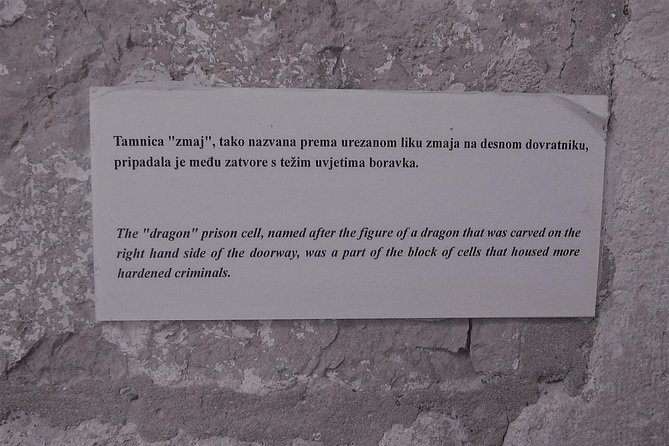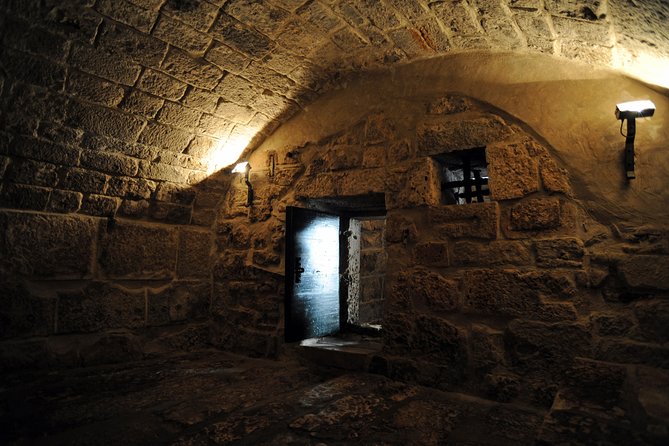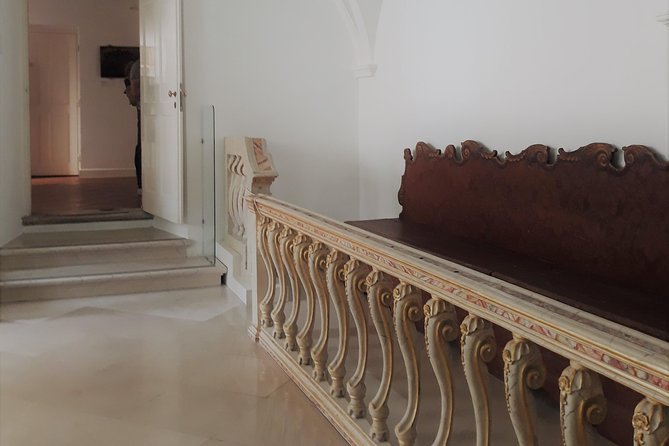Dubrovnik’s medieval justice system was a complex tapestry, interweaving authority, societal norms, and even religious influence. Public executions like hangings and beheadings served as both punishment and spectacle, drawing crowds to witness the fates of infamous criminals. The Rector’s Palace, a hub for adjudicating crimes, held hearings for characters like the notorious "Arson Twins." As moral and legal judgments were deeply intertwined, understanding Dubrovnik’s approach to crime and punishment provides insight into the city’s evolving social order. What tales of justice and injustice lurk within Dubrovnik’s historic walls?
Key Points

- Gradac Park was the site of public executions in Dubrovnik, featuring hanging and beheading of criminals for various offenses.
- Pile Gate, Dubrovnik’s iconic fortified entrance, was associated with the city’s dark criminal history and strategic importance.
- Stradun’s backstreets housed the medieval court, notorious prison, and sites of public floggings and punishments.
- The medieval justice system in Dubrovnik involved complex legal frameworks, with punishments ranging from public flogging to imprisonment.
- The Catholic Church’s influence on the penal system in Dubrovnik led to the intertwining of religion and justice in maintaining social order.
Gradac Park and Public Executions

The tour begins at Gradac Park, the former site of public executions in Dubrovnik. This tranquil green space was once a grim stage for justice, where criminals were hanged or beheaded for their crimes.
Visitors can stand in the very spot where these punishments were carried out, gaining a somber understanding of the city’s dark past. The guide shares vivid details about the execution methods and the crowds that gathered to witness them, providing a chilling glimpse into Dubrovnik’s criminal history.
This stop sets the tone for the rest of the tour, preparing participants to explore the city’s shadier backstreets and uncover more tales of law and disorder.
You can also read our reviews of more tours and experiences in Dubrovnik.
Entering the Old City Through Pile Gate

After experiencing the somber history of public executions at Gradac Park, the tour moves on to the western entrance of Dubrovnik’s Old City – the iconic Pile Gate.
This fortified gate, dating back to the 15th century, marks the transition from the modern city to the ancient walled town. Participants walk through the impressive archway, imagining the criminals and condemned individuals who once passed through its halls.
The guide shares tales of the gate’s strategic importance and its role in Dubrovnik’s storied past. With the Old City now within reach, the tour continues its exploration of Dubrovnik’s dark criminal history through the picturesque backstreets and medieval courtyards beyond the Pile Gate.
Stradun’s Backstreets and Crime Hotspots

From the iconic Pile Gate, the tour ventures into the winding backstreets of Stradun, Dubrovnik’s main thoroughfare.
Marija, the knowledgeable guide, leads the group through these lesser-known alleyways, revealing the city’s dark past.
The tour explores several significant historical sites, including:
- The former location of the medieval court, where trials and sentencing took place.
- A notorious prison, now a museum, where criminals were once held.
- The site of public floggings and other forms of public punishment.
- The spot where a famous serial killer was apprehended centuries ago.
Through Marija’s captivating storytelling, participants gain a unique perspective on Dubrovnik’s criminal history, seeing the city’s gritty past.
The Medieval Court and Justice System
Leaving the backstreets behind, the tour now focuses on the inner workings of Dubrovnik’s medieval court and justice system.
Visitors step inside the imposing Rector’s Palace, which once housed the city’s governing body and judicial proceedings. Here, they’ll learn how crimes were adjudicated, with punishments ranging from public flogging to imprisonment.
The tour guide delves into the complexities of the medieval legal framework, shedding light on the power dynamics and social hierarchies that influenced judicial outcomes.
Participants gain a deeper understanding of how justice was administered in Dubrovnik’s past, shaping the city’s enduring criminal history.
Infamous Dubrovnik Criminals and Their Fates
Beyond the confines of the formal judicial process, the tour delves into the captivating tales of Dubrovnik’s most infamous criminals and their ultimate fates.
Visitors learn about:
-
The "Arson Twins" who burned down a local inn, only to be publicly hanged for their crimes.
-
The notorious "Pickpocket Princess" who terrorized the Stradun with her skilled thievery before facing a gruesome fate.
-
The rebellious "Smuggler King" who challenged the authority of the Republic, meeting a grisly end as an example to others.
-
The treacherous "Poisoner’s Circle," a secretive cabal whose members met untimely and mysterious deaths for their nefarious activities.
The Role of Religion in Punishment
The Catholic Church played a pivotal role in shaping the penal system and punishment practices in old Dubrovnik.
As a deeply religious society, the city’s legal code was heavily influenced by Catholic doctrine. Crimes were often viewed as sins against God, and punishment was seen as a means of atonement and moral correction.
Religious authorities closely collaborated with secular courts, ensuring that sentences aligned with Catholic teachings. Public executions, for instance, were conducted with solemn rituals and the presence of clergy, underscoring the divine significance of the proceedings.
This intertwining of religion and justice was integral to Dubrovnik’s approach to maintaining social order and morality.
Evolving Attitudes Towards Crime Over Time
Attitudes towards crime and punishment in old Dubrovnik evolved over time, reflecting broader societal changes. As the city developed, its approach to justice shifted from public displays of brutality to more measured and humane practices.
This transition can be seen through four key developments:
-
The decline of public executions, with punishments moving behind closed doors to maintain public order.
-
Greater emphasis on rehabilitation rather than pure retribution, with the introduction of incarceration and labor-based sentences.
-
Increased recognition of mitigating circumstances and individual culpability, leading to more nuanced judgments.
-
Gradual professionalization of the justice system, with specialized roles and procedures.
These changes mirrored Dubrovnik’s transformation from a medieval city-state to a more complex, modern society.
Personalized Insights From Your Local Guide
One key highlight of the crime and punishment tour is the personalized insights provided by your local guide, Marija.
As an expert on Dubrovnik’s history, Marija offers a unique perspective that brings the city’s dark past to life. Participants appreciate her engaging storytelling, which delves into the motives and methods behind historical crimes and punishments.
The private tour format ensures an intimate experience, often with just your group, allowing Marija to tailor the content to your interests.
Her extensive knowledge and passion for the subject matter make for a truly immersive and memorable exploration of Dubrovnik’s criminal history.
Frequently Asked Questions
What Are the Tour Departure and Return Times?
The tour doesn’t specify exact departure and return times. It notes the meeting point is at Ulica Dante Alighieri, in front of Sesame restaurant, and the tour ends at the Rectors Palace, either inside or in front of the palace.
Is the Tour Audio-Guided or Conducted by a Live Guide?
The tour is conducted by a live guide, Marija, who provides engaging storytelling and unique insights into Dubrovnik’s criminal history. Participants appreciate the personalized experience of the private tour format.
Are There Any Age Restrictions or Suitability for Children?
The tour is not recommended for children as it covers sensitive historical topics related to crime and punishment. However, most adult travelers can participate, as the walking level is moderate and the tour provides a personalized experience.
Is Photography Allowed During the Tour?
Photography is allowed during the tour. The tour guide encourages participants to take photos of the historical sites and scenery they encounter along the way to capture their experience.
What Is the Cancellation and Refund Policy?
The tour has a flexible cancellation policy – customers can cancel for a full refund up to 24 hours before the start time. Refunds are not available for no-shows or same-day cancellations.
Recap
Crime and punishment in Old Dubrovnik were deeply rooted in the city’s complex medieval justice system, where public executions and the influence of the Catholic Church intertwined morality and law. From infamous criminals facing dire fates to evolving societal attitudes, this historical narrative sheds light on how justice was perceived as a means of maintaining social order in the Old Dubrovnik context.
More Tour Reviews in Dubrovnik
- Mostar, Pocitelj and Kravice Waterfalls Private Tour From Dubrovnik
- Adventure Park Cadmos Village From Dubrovnik
- SUP Rental Half-day (4h) Dubrovnik Old Town
- Half Day Dubrovnik Countryside Gastro Experience
- Elaphite Islands: Luxury Sailboat & Speedboat Tours
- Montenegro Full Day Trip From Dubrovnik (Small Group)
Not for you? Here's more things to do in Dubrovnik we have recnetly reviewed
- 18 Best Canoe And Kayak Experiences In Dubrovnik
- 5 Best Dining Experiences In Dubrovnik
- 4 Best Dinner Tours In Dubrovnik
- 5 Best Shopping Tours In Dubrovnik
- 25 Best Canoe And Kayak Experiences In Dubrovnik
- 20 Best Full-Day Tours In Dubrovnik
- 3 Best 2 Day Tours In Dubrovnik
- 7 Best Photography Experiences In Dubrovnik
- 25 Best Cruises And Boat Tours In Dubrovnik
- 12 Best Jet-Ski Experiences In Dubrovnik
- 25 Best Lunch Experiences In Dubrovnik
- 19 Best Food Tours In Dubrovnik
